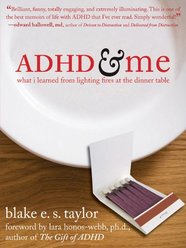 ADHD & Me, written by Blake E. S. Taylor (2007, New Harbinger Publications, Oakland, CA) is a memoir about growing up with Attention Deficit Hyperactivity Disorder. The author, currently a student at UC Berkeley, has a charming and very real voice throughout the book. Sometimes the book reads almost like a high school science report, which I think makes it more accessible for young readers. I recommend this book as something parents can read to help understand their own child with a diagnosis of ADD or ADHD. More than a book for parents though, I think it’s a great read for kids trying to deal with their own diagnosis. Because the book breaks down into chapters dealing with different issues, such as “being disorganized” or “being unpopular” it can be useful for kids dealing with all sorts of social, home, or school problems, whether it’s due to ADHD, autism and ASDs, Asperger’s syndrome, or non-diagnosed issues with executive functioning or reading social cues. For each chapter, the author begins by presenting an illustration from his own life, showing how the specific issue impacted him. He then moves into his own analysis of why this issue comes up. Each chapter ends with the author’s suggested solutions for how to deal with the issue. Because the author just recently graduated from high school, his ideas may be more realistic than those of adults who were in school years ago. For children and their parents who are feeling mistreated by a world that doesn’t always accept those who are different, this book could be a great support. The author comes right out and discusses the ideas of being treated unfairly by peers in chapters such as “being bullied” and “being isolated” while at the same time looking at his own contribution to the problems. He’s also direct about discussing the negative attitudes he’s encountered from adults, in chapters such as “being discriminated against” and “being blamed”. There are empowering ideas here for kids who are struggling with the realities of dealing with both peers and adults. The best part of the book is the final two chapters, “taking control” and “being gifted”. In ADHD, as with any difference, there are strengths as well as difficulties. Too often children, parents, and teachers are focused on the issues and their solutions, and the gifts and advantages that come with that difference are overlooked. The author lists all the ways in which his ADHD diagnosis can be a benefit, such as creativity and high energy. Seeing this list in a published book may be just what a child needs to be able to take a fresh look at his or her own diagnosis. Eye contact can be a tricky issue for some people. When to look someone in the eye, when to look away, does lack of eye contact indicate unfriendliness, does eye contact that too lengthy indicate a threat? A lot gets expressed and read into a seemingly simple gesture. The confusion gets compounded by the fact that different cultures have different rules for eye contact, and the rules within families can be different than those for friends, acquaintances or strangers. What’s praised as “paying attention” for some cultures is then criticized in others as “not being respectful.” Many people struggle with reading social cues. For example, a recent study from Indiana University and Yale pointed out how frequently male and female students mistook friendliness for sexual interest and vice versa. (See http://newsinfo.iu.edu/news/page/normal/7883.html for a brief article on the study.)
Kids with social skills issues, such as those with autistic spectrum disorders, Asperger’s Syndrome, and some kids with ADHD are frequently instructed in the “rules” about eye contact. As a therapist, I think it’s important to use great care with this issue. There are reasons the neurotypical world uses eye contact: as an indication of openness, interest, paying attention, as well as to convey less friendly messages such as boredom or dominance. At the same time, there are plenty of good reasons why an individual may not be comfortable using the standard rules of eye contact. Just go online and read some of the blogs from adults with Asperger’s syndrome and you’ll find great discussions about how eye contact can feel threatening, distracting, or overwhelming. For parents who aren’t sure what to do for their kids, I think the individual approach is best. Try talking to your child about it. See if you can figure out together if there are any problems due to eye contact or the lack of eye contact. Then it can be easier to come up with solutions. If your child can’t figure out when others have lost interest in his conversation, then learning to do an eye contact check-in may suddenly seem worthwhile, instead of an arbitrary rule made up by the neurotypical world. If your child is concerned with making friends but overwhelmed with the intimacy of eye contact, then learning to fake it may make sense. Practicing for a job interview or date may motivate some people. Th real key is that the focus, for this and any other social skill, should be finding solutions to problems and issues, not on teaching children complicated sets of rules for how to act like everybody else. I’ve been very busy this week because I’m “attending” an online conference. It’s the basic course on DIR® and Floortime™ therapy from Dr. Stanley Greenspan. He talks about autism, Asperger’s, sensory integration issues, auditory processing and a range of learning issues, and his model for treating these children. The course consists of about 15 hours of video tapes from a conference where Dr. Greenspan presented in 2005.
The best part is the many videotaped segments of Dr. Greenspan coaching parents as they try to do Floortime™ with their own children. He’s got a varied group of children on the autistic spectrum, from very young babies to school age kids, and the parents range from gifted to skeptical. With this online format, it’s possible to watch these tapes over and over, because there is a lot going on in these segments. Dr. Greenspan admits that the tapes are showing the best moments of these interactions, but even so, they are impressive. The children’s affect, interaction, and relating, in other words: social skills, feel so genuine and natural. I love to see the parents involved and empowered. This conference is still open to those who are interested. Both parents and professionals are taking it. Check out http://stanleygreenspan.com/iec/content/iec-conference-online if you’re interested. |
Patricia Robinson MFT
I'm a licensed therapist in Danville, California and a coach for Asperger's and ADHD nationwide. I work with individuals of all ages who have special needs, like Autism Spectrum Disorders, ADD, ADHD, and the family members and partners of special needs individuals. Archives
February 2015
Categories
All
|

 RSS Feed
RSS Feed